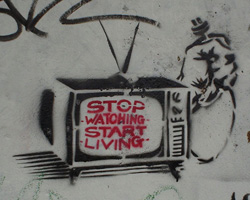Why Turning Off Your TV is a Good Thing.
I have said for a couple of years that I was going to do it, but it just has never been the right time: Fall season starting, the Tour de France is on OLN, Shark Week is on Discovery, etc… etc… I didn’t really hit a rock bottom with the TV, I just decided enough was enough, called the cable company and just did it. Now it wasn’t as easy as it sounds. The lady on the phone offered me all sorts of deals and specials and tried to reason with me about how enriched I was because of Telemundo, QVC and the other 90 channels that I don’t watch. I told Laurel after the fact and she was a little horrified as well. She talked me into just keeping the local channels for $10 a month. It remains to be seen if that was a mistake, but I can say that I sometime go days without turning on the TV.
Some things are already changing for the better. I am listening to the radio in the morning instead of watching TV, which means that I am informed and entertained while getting ready and I’m not sucked into the void in the middle of the box in my living room. I have listen to and enjoyed it so much lately that I felt guilty when the local public broadcasting station (KPCC) was having a fund drive. I called in and gave them dollar a day. Even with my support of public radio, I will still save close to $120 this year on the cost of cable television.
Back to the issue at hand -- I have resolved to read all the books that have been piling up, read each of the three magazines that I have a subscription to -- BEFORE the next month’s issue comes, write more, and watch quality movies and series on DVD whenever I have the need to stare at a flickering box for an hour or so. Though, I don’t want to replace one televised vice with another. Not all TV watching is bad. I have learned a great deal about life, history, and the world from TV as a child and as an adult. Moderation is the key and I need to learn how to balance my TV consumption with all the other things that make like full and colorful and tactile.
Some numbers from the A.C. Nielsen, Co. for you to ponder:
• The
number of television sets in U.S. households in 2001: 248 million
• The percentage of households with at least one TV in 2001: 98.2%
• Percentage of U.S. homes with three or more TV sets: 66
• The average number of TVs per home in 2001: 2.24
• The projected number of hours that adults (age 18 and older) will
watch television in 2004: 1,669 (This is the equivalent of about 70 days.)
• Number of hours per day that TV is on in an average U.S. home:
6 hours, 47 minutes.
• Percentage of Americans that regularly watch television while
eating dinner: 66
• Number of hours of TV watched annually by Americans: 250 billion.
• Value of that time assuming an average wage of $5 an hour: S1.25
trillion
• The percentage of people age 18 and over who said they watched
television in the spring of 2002: 94.3%
• Older Americans (age 65 and over) were more likely to be glued
to the tube (97 percent) than any other age group.
• Percentage of Americans who pay for cable TV: 56
• The projected spending per person for cable and satellite TV in
2004: $255.18
• The estimated average monthly rate for cable TV in 2002: $34.71
• The number of stores that primarily sold televisions and other
electronic equipment in 2001: 21,724
• Number of videos rented daily in the U.S.: 6 million
• Number of public library items checked out daily: 3 million
• The annual payroll for the 245,000 employees of 6,692 cable TV
networks and program distribution firms in the United States in 2001:
$11.7 billion
• The number of television broadcasting networks and stations in
the United States in 2001: 1,937
• Percentage of Americans who say they watch too much TV: 49
• Approximate number of studies examining TV's effects on children:
4,000
• Number of minutes per week that parents spend in meaningful conversation
with their children: 3.5
• Number of minutes per week that the average child watches television:
1,680
• Percentage of day care centers that use TV during a typical day:
70
• Percentage of parents who would like to limit their children's
TV watching: 73
• Percentage of 4-6 year-olds who, when asked to choose between
watching TV and spending time with their fathers, preferred television:
54
• Hours per year the average American youth spends in school: 900
hours
• Hours per year the average American youth watches television:
1500
• Number of 30-second TV commercials seen in a year by an average
child: 20,000
• Number of TV commercials seen by the average person by age 65:
2 million
• Percentage of survey participants (1993) who said that TV commercials
aimed at children make them too materialistic: 92
• Rank of food products/fast-food restaurants among TV advertisements
to kids: 1
• Total spending by 100 leading TV advertisers in 1993: $15 billion
• Percentage of local TV news broadcast time devoted to advertising:
30
• Percentage devoted to stories about crime, disaster and war: 53.8
• Percentage devoted to public service announcements: 0.7
• Percentage of Americans who can name The Three Stooges: 59
• Percentage who can name at least three justices of the U.S. Supreme
Court: 17

Found on a wall in Glasgow, Scotland
Photo taken by Brian Aslak Gylte